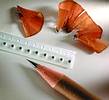USB2.0-compatible low profile chip common mode choke coils
9 April 2003
Circuit & System Protection

Murata has introduced a new series of chip common mode choke coils. The DLP11 series provide high levels of EMI noise suppression in high-speed differential mode signal transmission lines such as USB2.0. They are compact, low profile, and are said to be the smallest USB2.0 common mode choke coils available.
Murata thin film and ferrite material technologies have produced choke coils that handle high-speed data transmission in a compact and low profile volume of 1,25 x 1,0 x 0,82 mm. With an electrode pitch of 0,55 mm, they contribute to high density mounting in compact designs like mobile equipment. Moreover, with a magnetic coupling factor of 0,98 or more, the differential mode impedance that may cause signal waveform distortion in the signal pass band is reduced to low values. As a result, common mode noise is effectively removed without influencing high-speed signal waveforms.
A lineup of four values is available, with common mode impedance values of 90, 120, 160 or 200 Ω (at 100 MHz).
With data processing speeds in personal computers and their peripherals becoming faster and faster, high-speed differential signals such as USB2.0, IEEE1394, and LVDS serving as interfaces between computers and peripherals have become widespread. A common mode choke coil that effectively removes noise without influencing signal waveforms is useful as noise suppression in high-speed differential mode signal transmission lines.
Applications are for noise suppression in high speed differential signal lines of compact, mobile equipment such as digital still cameras, video cameras, mobile phones, PDAs, and notebook computers; noise suppression in USB2.0 (High-Speed) D+/D-lines; noise suppression in IEEE1394 TPA± TPB± lines; noise suppression in clock and data lines such as LVDS/DVI (TMDS).
For more information contact Avnet Kopp, 011 809 6100, [email protected], www.avnet.co.za
Further reading:
Clearing the Static: Staying grounded
Actum
Circuit & System Protection
To maintain reliable electrostatic discharge control, regular testing and accurate measurement are essential, with grounding products and ESD testing equipment being vital.
Read more...
Smarter protection without disruption
NewElec Pretoria
Circuit & System Protection
Designed for operations still running without integrated automation, NewElec’s retrofit-friendly systems let you upgrade performance and safety without overhauling your entire network.
Read more...
Circuit breaker for reliable, compliant protection
RS South Africa
Circuit & System Protection
Legrand’s low-voltage power distribution portfolio encompasses the DX3 range of miniature circuit breakers, designed to deliver dependable protection in residential, commercial and industrial installations.
Read more...
Reducing noise on power supply lines
Future Electronics
Circuit & System Protection
Murata has introduced the EMIFIL ESD Series Noise Filters, a breakthrough solution engineered for superior noise suppression and enhanced electrostatic discharge (ESD) protection.
Read more...
Clearing the Static: Fundamental principles of static control
Actum
Circuit & System Protection
Controlling electrostatic discharge in electronics manufacturing is essential with effective ESD programs built on six key principles.
Read more...
Electrical fire safety in lithium-ion battery rooms
Circuit & System Protection
Pratliperl is a non-combustible, ultra-lightweight aggregate that can be mixed with cement and applied as a plaster or screed to walls, floors, and ceilings.
Read more...
Clearing the Static: ESD training in the workplace
Actum
Circuit & System Protection
To protect sensitive electronic components, A structured, consistent, and sustainable ESD training program is essential.
Read more...
Protect your pumps – protect your profit
NewElec Pretoria
Circuit & System Protection
In South Africa’s demanding agricultural landscape, irrigation is not just an essential service – it is the heartbeat of farm productivity.
Read more...
Clearing the Static: ESD and installation: A durable antistatic solution
Actum
Circuit & System Protection
ESD flooring provides a reliable, long-term solution for managing static electricity by safely dissipating static charges through the floor to a designated ground point.
Read more...
Why wait to automate
NewElec Pretoria
Circuit & System Protection
NewElec’s initiative helps you gain operational visibility via HMI or PLC by retrofitting intelligent motor protection relays without replacing MCCs or rewiring the plant.
Read more...


